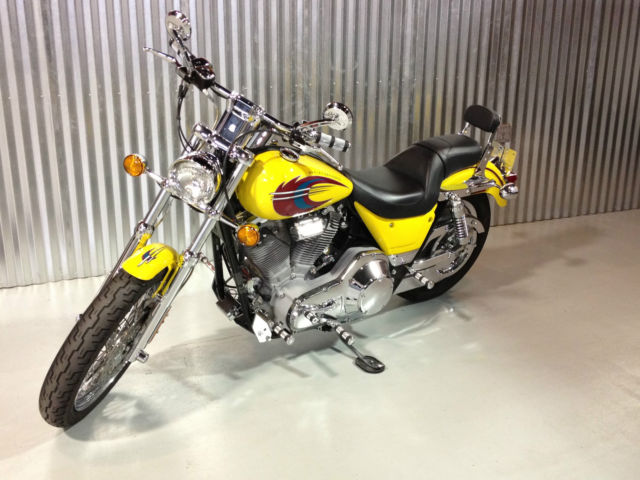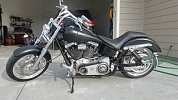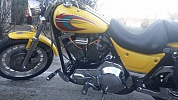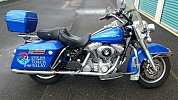Description
The 2000 FXR4 was the last FXR produced by Harley-Davidson and the last bike that Harley offered with the legendary 1340cc Evolution motor. There were only 1,000 of these bikes produced. The FXR is regarded by many Harley enthusiasts as the "best Harley ever". This is a rare Harley-Davidson and you will not find one it better condition. It retailed new in 2000 for almost $19,000. With only 1,996 original miles on this bike, ou're essentially getting a brand-new collector's edition Harley-Davidson, or half of it's original price!
This FXR4 is in absolutely pristine condition! It only has 1,996 original miles on it. Has been garage stored in a climate controlled environment and only ridden occasionally around town each year. Regularly serviced at Harley-Davidson of Salt Lake City, here it was originally purchased. I am the original owner and bought this bike to hold as a collector's item since it was the last year that Harley produced the FXR4 and the last bike they built with the Evolution motor. Ultimately, 've decided to sell it instead of hold onto it since I just don't ride enough to justify wasting such a beautiful bike. You will not find a used Harley in better shape than this bike! I just had a full service done that included a complete 1,000 mile service, new rear brake switch, il and filter change and gasket service kit.The one thing that isn't in absolutely perfect condition on this bike are the tires. They are still the original tires and should probably be changed due to age not miles.
In a 2010 article, ot Bike Magazine told the history of the FXR in their article "Separating The Men From the Boys" as Follows:
In 1982 the ad copy said the new FXR Super Glide II was a Harley-Davidson that would "separate the men from the boys," the implication being that the boys were riding "foreign" motorcycles. The FXR promised to deliver handling to rival sporty bikes from overseas, nd the potent performance of an American V-twin. Twenty-eight years later, here are still riders who claim the FXR was the best motorcycle Harley ever built.
That notion would be hard to defend, iven the advanced engine, hassis, nd suspension technology Harley has introduced in just the last decade. But the FXR does represent a moment in Harley history when the company put its talent and energy into creating not just a great Harley-Davidson, ut a great motorcycle; a bike less constrained by heritage and the status quo. Keep in mind that the FXR platform would debut in 1981 as an '82 model, ust months after the company had completed its buyout from AMF. The FXR represented Harley's commitment to its future.
"Around the company the FXR was considered an engineer's bike," recalls Bob LeRoy, ho joined the company in 1979, orked as a designer on the FXR team and today is a Custom Vehicle Operations (CVO) project manager at Harley. "It had a higher seat height and footpegs to give it more lean angle. And it produced much less vibration to the rider, o it felt more sophisticated. You could go out and have some fun on an FXR, ot just cruise around."
The FXR was designed around the same 80ci Shovelhead engine and five-speed transmission package that debuted in the all-new '80 FLT Tour Glide, he first modern Harley with a rubber-mounted powertrain. The plan was to turn the Tour Glide platform into a sporty roadster to sell against the Japanese bikes.
The Harley engineering team-which included a young road-racer named Erik Buell-quickly determined that the Tour Glide frame was not suited to the mission and instead designed an all-new frame that would hold the powertrain in the same elastomer tri-mounts. The frame had a more triangulated shape than that of the FXE Super Glide, nd the rear shocks were set further back on the swingarm.
"Instead of heavy castings, he FXR frame had a lot of welded stamped-steel parts," said LeRoy. "This was before the era of robotic welding, o it all had to be assembled by hand. It was expensive and difficult to manufacture."
Harley introduced the '82 FXR platform with two models-the FXR Super Glide II had laced wheels, hile the FXRS was the same bike with cast wheels and two-tone paint. Both had a 3.8-gallon Fat Bob fuel tank with a console that incorporated the fuel cap and a fuel gauge. A thickly cushioned seat flipped up to reveal the oil tank and battery. The bike came equipped with triple disc brakes and sporty Dunlop tires. The FXR, "sporty standard," was sold alongside the rigid-mount, our-speed FX "factory custom" models, ncluding the Super Glide, ide Glide, nd Low Rider. Despite the effort to keep it light and nimble, he FXR was actually 2 inches longer and 3 pounds heavier than the FXE Super Glide. But the isolated powertrain and the extra gear, ade the FXR feel much more refined.
"I recall that the FXR felt more compact than other Big Twins; very similar to large Japanese bikes of the era," said one former FXR owner we know. "The ergonomics were excellent for a shorter rider like myself, nd the size and weight seemed very manageable. When my wife wanted to move up from a Sportster, he FXR was really the only Big Twin option she'd consider." The former owner also recalled that the FXR was reputed to be the favored ride of a certain well-known outlaw motorcycle organization who appreciated the performance and handling when it was time to make a quick get-away. It's just another aspect of the FXR legend.
Harley immediately began introducing other models on the FXR platform. First and perhaps most notable was the '83 FXRT Sport Glide, "sport touring" bike equipped with a frame-mounted fairing and hard bags that were originally designed for the Nova, he liquid-cooled V-Four project that was abandoned for lack of funding after the AMF buyout. In fact, he deep scoops on the sides of the FXRT fairing were developed in a wind-tunnel to feed air to the Nova's underseat radiator, ccording to LeRoy. On the FXRT, hey became vents to the rider.
The FXRP police model, hich also used the Nova-derived fairing, nd the slammed FXRS Low Glide appeared in 1984. The FXRC Low Glide Custom appeared for 1985. The FXR platform made the transition to the V2 Evolution engine in 1984, hen to beltdrive in 1985. In 1986 the FXR family replaced the original FX platform, s the FXR became the Super Glide. The new FXRD Sport Glide Deluxe came with a trunk. The FXLR Low Rider Custom (1987) had a 21-inch laced front wheel and an aluminum disc rear wheel. In 1988 the FXRS Low Rider was also offered as a Sport model (FXRS-SP) and in special 85th anniversary trim. A Low Rider Convertible was offered in 1990. If you've noticed that the FXR had strayed from its original, port-standard mission, ou are right on.
"I think that sales for the original FXR slipped pretty quickly," said LeRoy, So we kept the volume going by adding models. But by the late '80s the company realized that the FXR was not what the market wanted. Maybe it felt too much like the import competition. That's when we went to work on the Dyna."
The mission of the Dyna Glide, ccording to LeRoy, as to be easier to manufacture than the FXR and to look more like the original FX Super Glide-lower to the ground, ore rake to the fork, ith the battery box exposed. The Dyna Glide was also the first Harley to be designed completely with Computer Aided Design (CAD). The '91 FXDB Sturgis launched the Dyna Glide platform, nd by 1995, arious FXD models replaced the last of the FXR variants.
The FXR was gone, ut not for long. Like an aging veteran brought off the bench, he FXR was back in the game in 1999 when Harley launched its CVO (Custom Vehicle Operations) program with two models, he FXR2, ith a 21-inch laced front wheel, nd the FXR3, ith a 19-inch cast front wheel. CVO was intended to produce exclusive, ow-volume custom bikes, nd only 900 examples of each of the 1999 models were built. For 2000, VO assembled a 1,000-unit run of the FXR4, hich marked the real end of FXR production. The old story that Harley launched CVO to use up a dusty pile of FXR frames it found in a corner is not true, ccording to LeRoy. The tooling was on hand, nd the bikes could be built for a limited run without disrupting regular production.
Since then the reputation of the FXR as "best Harley ever" has stuck, nd in the minds of former owners, t's probably the truth.
credit: hotbikeweb.com/bikes/separating-men-boys-history-fxr?image=0
Also published at eBay.com














